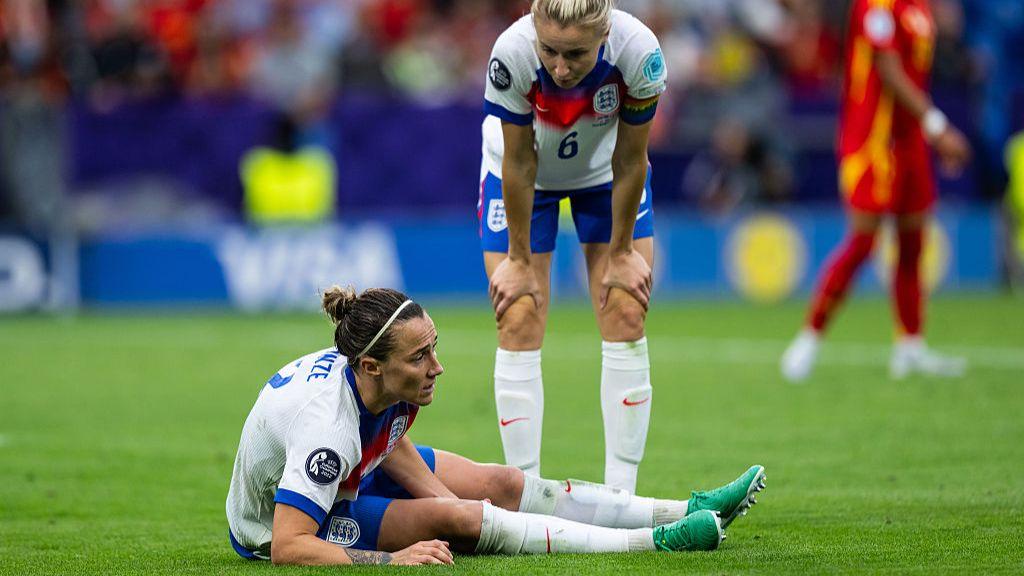In a remarkable display of resilience and tenacity, England defender Lucy Bronze played the entirety of the Euro 2025 tournament with a fractured tibia, a fact that only came to light after her team’s victory over Spain in the final. This disclosure raises significant questions about the limits of athletic endurance and the support systems in place for elite athletes facing injury.
Following England’s triumphant match culminating in a win against Spain, Bronze revealed her injury to the public, stating, “I actually played the whole tournament with a fractured tibia, but no-one knew.” This admission was corroborated by her mother, Diana Bronze, who detailed that Lucy suffered the injury in June. Despite this setback, she remarkably played all six matches of the Lionesses in Switzerland, demonstrating extraordinary resolve and athletic prowess. Diana recounted to BBC Radio 4’s Women’s Hour that the medical staff were aware of the injury, remarking, “We’ve known all the time.”
Understanding a tibia fracture is essential in contextualizing Bronze’s accomplishment. Dr. Mark Bowditch, President of the British Orthopaedic Association, explained that the tibia, commonly known as the shin bone, bears significant weight between the knee and ankle. He noted that fractures range in severity and can either be partial, such as a stress fracture, or complete—an injury that typically results from significant impact. Given the nature of her injury, it’s likely that Bronze contended with a stress fracture, a condition that tends to manifest pain following activity without an acute incident leading to injury.
The medical insights surrounding her situation reveal a conflicting landscape of possibility and risk. England manager Sarina Wiegman commented that Bronze faced “issues with her tibia,” indicating attempts to manage her condition throughout the tournament. Nick Worth, a former physiotherapist for the England men’s under-21 team, suggested that there were likely considerations made regarding the risks versus rewards of allowing Bronze to play despite her injury. He noted that such decisions usually involve collaborative planning with medical professionals to ensure the athlete’s health remains optimal.
Despite potential pain and pressure from her injury, Bronze exhibited fantastic stamina throughout the tournament, playing nearly 600 minutes on the field, trailing only a few fellow teammates in total minutes logged. Such a feat is deemed “remarkable” by experts like Dr. Bowditch, who speculated that she most likely engaged in reduced training to manage her condition. Utilizing low-impact training environments, such as swimming pools, may have played a role in allowing her to sustain her performance levels.
Moreover, it has been suggested that psychological factors, such as mental resilience, might contribute to an athlete’s ability to cope with injury. Bronze’s aunt, Julie Tough, highlighted her niece’s willingness to play through pain, reassuring that Lucy wouldn’t exacerbate her condition by playing cautiously. Pain management strategies, such as painkillers or specialized insoles in her football boots, could have also supported her during the tournament.
What lies ahead for Bronze in her recovery is uncertain without a complete diagnosis of her injury. Dr. Bowditch warned that it was crucial to monitor her condition closely to prevent the potential evolution of a partial fracture into a complete break. Recovery could involve a necessary resting period or even surgical intervention, should it be needed to facilitate proper healing.
As the dust settles on Euro 2025, Bronze’s experience raises essential discussions regarding athlete health and care, the psychological fortitude required to overcome physical limitations, and the lengths competitors will go to in pursuit of victory. Her story stands as a testament not only to her personal courage but also to the complex relationship between athletic excellence and injury management in sports today.












